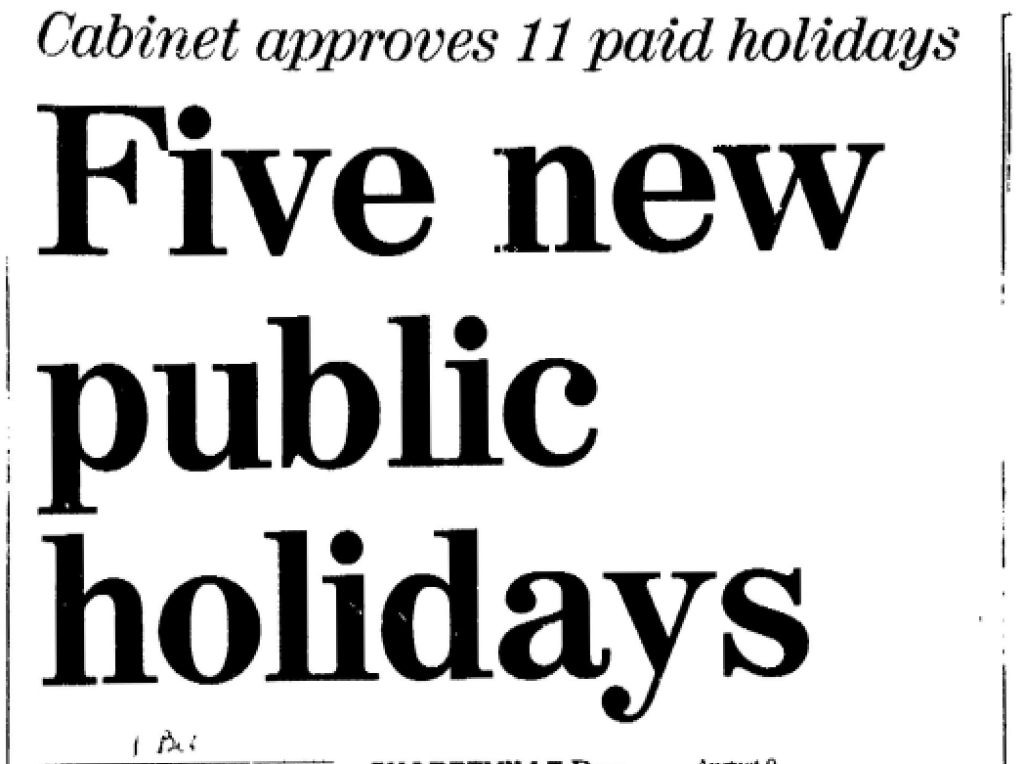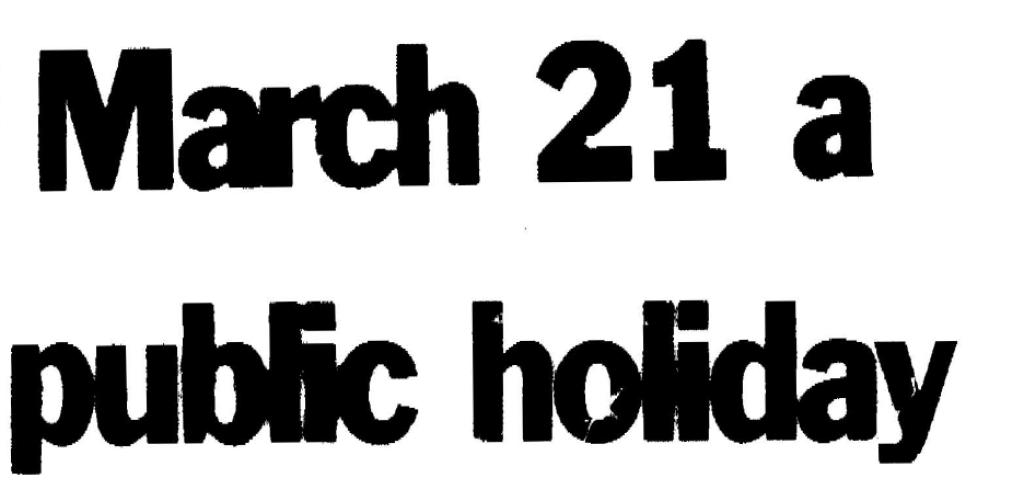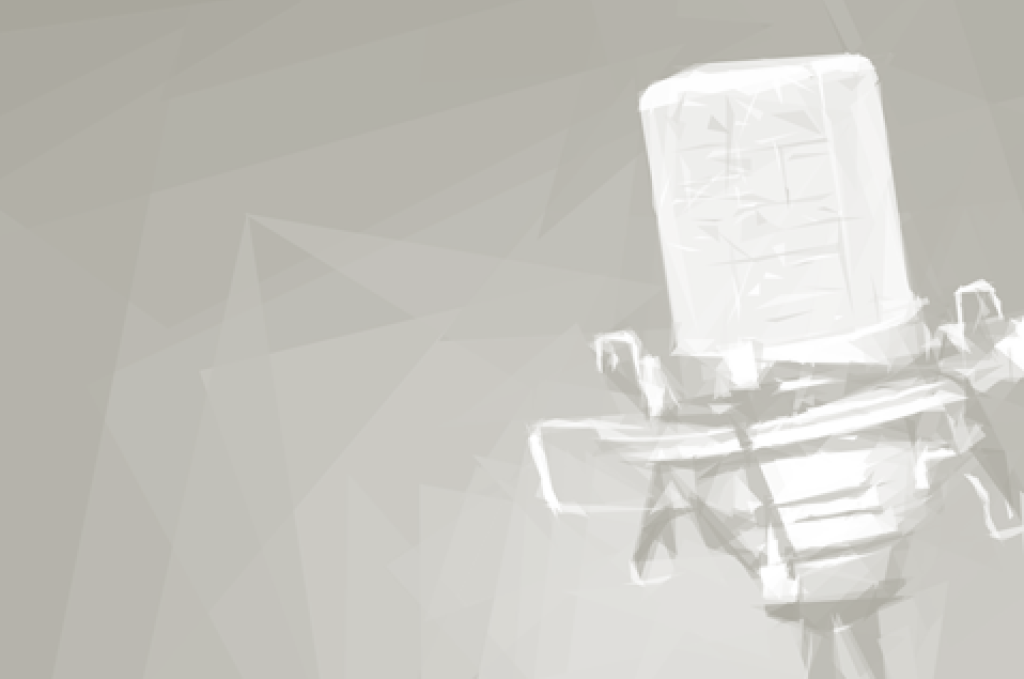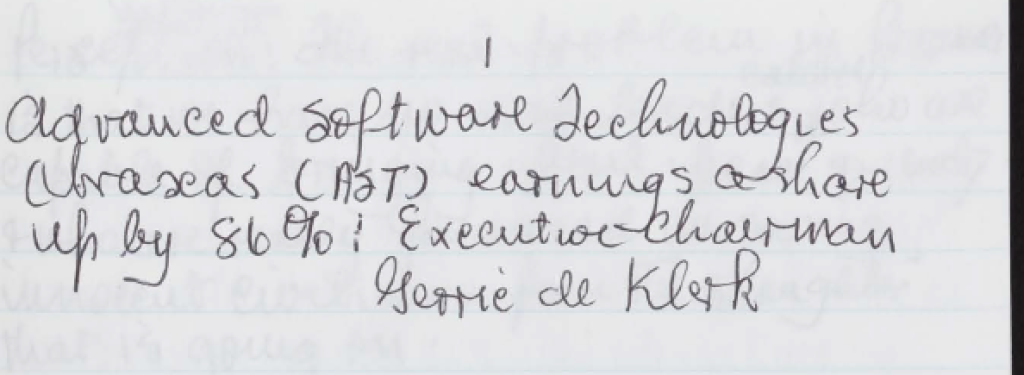The quest for national unity was pervasive, and informed the shape and composition of institutions as much as political engagement. It was a preoccupation of Mandela’s that each and every person should, whether as member of a particular social group or supporter of a political party, feel able to identify with the new democratic system, by seeing themselves represented in the Government of National Unity and in the country’s institutions. It was in that spirit that he made efforts to involve the smaller parties in government and to be sensitive to how they regarded the institutions and symbolism of the new South Africa.
Mandela, responding to PAC anger, fought, virtually alone, to get March 21 recognised as a public holiday (Human Rights Day) after Cabinet had adopted and announced a list of national days that excluded the anniversary of the 1960 Sharpeville massacre.561 The fight was mainly around the issue of the number of holidays, with some sectors already complaining that the holidays announced by Cabinet were too many, but in the end March 21 was included.562
If the Afrikaner community and its formations were the principal focus of Mandela’s reconciliation efforts, as he acknowledged, it was because it harboured the greatest potential for resistance and at the same time would be able to make a big contribution to the future. However the emergence of a new nation would depend on a much broader effort. And so, over and above the general message of national unity, Mandela and the ANC interacted with each sector, group and community that had distinct organisation and cultural or occupational institutions, both before and after the election of 1994.
If there was a pattern in these wide-ranging engagements, it combined reminders of history with emphasis on responsibility of all for the future.
In interactions with cultural, commercial or religious organisations amongst the Greek, Italian, Portuguese, Jewish or other communities, he would recognise contributions members of the community had made to the struggle for freedom, and stress the obligation to help build the future using the resources and skills the community had accumulated due to its privileged position in the past.


The interactions were also opportunities to deal with issues that might be on the community’s mind – explaining to the Jewish community the government’s approach to the Middle-East; persuading the Chinese community grieving for a murdered member that the fight against crime could be won without the death penalty;563 urging cultural and commercial associations of Greek and Italian communities to join in the reconstruction and development of the country, as part of a united South African nation.564
When referring to the Black majority who had been oppressed and discriminated against under apartheid, Mandela would habitually explain, closer to language of the Freedom Charter, ‘that is, African, Coloured and Indian.’ Interaction with the Indian and Coloured communities was a strong focus, sharpened by the divisions imposed by apartheid and by opposition party attempts to exploit fears amongst those communities of what democratic government could mean for them. He spelt out the challenge in 1991 at the ANC’s first national conference since its unbanning.


There has been no effective communication between the ANC and the minority groups of this country. Many of us have made the mistake of thinking that the mere declaration of our policy in the Freedom Charter, because it is the most progressive policy ever published by any political organisation in this country, meant that the masses would come rushing to join the ANC. This is not the position. Some of our structures have been so set up as to exclude the minority groups. That has been a serious weakness, because it indicates that the overwhelming majority of the Africans in this country are not taking into account the minority groups of this country. It is true that our policies are non-racial, but let us be realistic about it. There are different ethnic groups in this country, and ethnicity, especially because of the policies of the government, is still a dangerous threat to us. We have to redouble our efforts to make sure we have the confidence of all the different sections of the people of this country, something which is not there at the present moment.565

As noted earlier, in the 1994 election the National Party received a majority of votes in the still segregated Coloured and Indian areas. Mandela raised the matter later in the year when he received the freedom of the predominantly Indian town of Tongaat in Natal which had been a centre of resistance. After delivering his prepared speech he elaborated on a note he had added to the speech. In giving most of their votes to the National Party ‘they had decided to be part of a minority and not the majority. They decided to be part of a past which has divided us, created conflict, hostility, instead of being part of the future.’ Mandela recalled the oppression of Indian and Coloured communities under apartheid and forced removals and segregation in group areas. ‘In the forthcoming local elections you have an opportunity to correct the mistakes of the past.’567
In the frequent interactions with these communities that followed he drew on the history of struggle, sought to reassure them, in particular about affirmative action, and argued that their interests lay with being part of the majority. At a World Hindu conference in Durban in 1995 he paid tribute to the contribution of Hinduism to South African culture and political aspirations, and urged vigilance against those wanting to perpetuate the divisions of the past.

You have an opportunity to correct the mistakes of the past in the local elections.
Our land is graced by temples, altars and shrines built by the indentured labourers who first brought Hinduism to these shores and those who followed them. They testify to the indomitable spirit with which they sustained community and religion under adverse circumstances.
The nurturing of Hinduism in South Africa has been woven into the struggle for freedom and justice. The Hindu community has given our nation some of its most revered leaders, amongst them Mahatma Gandhi, Dr Monty Naicker, Mr Nana Sita and many others. In the past several Hindu leaders were in the forefront of the struggle against oppression. Today they represent our people as a whole in Parliament and the provincial governments, leading the transformation of our society in order to address the legacy of apartheid.
Our vision of a free and equitable society at peace with itself is also to be found in the core values of Hinduism: tolerance, peace and unity. These values, as expressed in the pronouncements and writings of Gandhi and Nehru, had a profound and lasting influence on our liberation movement, and on my own thinking.
The relevance of these values to our society has never been greater than in this time of nation building and national reconciliation. ...
Our country, freed at last from apartheid and minority rule, is going through a profound transformation. It is only natural that this process of change which brings much hope and promise, also has its share of anxieties.
As a nation we have set ourselves a bold challenge indeed. We are seeking to turn centuries of division and fear into unity and peace, and to do so in a matter of years. We are striving to transform our society in order to address the legacy of apartheid.. . .
The challenge we all face is to work together on the common ground that unites us, rather than allowing ourselves to be divided by the differences which may exist, which are much smaller.
This means joining hands to create a better life for all South Africans, by making a success of the reconstruction and development programme.
It means ensuring that the opportunities now opening up should benefit all those - particularly from the Indian, Coloured and African communities - who were excluded and held back by the discriminatory practices of apartheid.
We should all be alert to false claims, by those seeking to perpetuate the divisions and imbalances of the past that the government's policy of affirmative action is intended to benefit only one section of society. …
On the tenth anniversary of his release from prison, in February 2000, some months after leaving government, Mandela was invited to the inauguration of the Nelson Mandela Museum, a project celebrating his life and role in the struggle. It is based at three sites: Mvezo where he was born; Qunu where he grew up until the age of seven; and the nearby town of Mthatha. As he prepared for an occasion that was to be focused on himself and South Africa’s recent history, he drafted a speech to shift the moment to a much broader canvas.569 It was a lesson in history, a reminder of the breadth of contribution to a struggle that had endured over centuries and a re-statement of the principle, which he repeatedly stressed in other contexts, that national unity comes out of shared action for common goals.

. . .We should always remember that the South African struggle has a proud and long history stretching out for almost three and a half centuries.
In that struggle there were the Khoisan, the Bantu-speaking people, Coloureds, Indians and Whites, however few they might have been.
Some of our intellectuals and leaders fully appreciate this fact. But the overwhelming majority of our intellectuals and opinion-makers are not aware of this position. To them the struggle started with the Bantu-speaking people around the banks of the Great Fish River during the eighteenth century.
Yet it is common knowledge that the first freedom fighter in the history of this country was Autshumayo, others call him Hadah, others call him Harry the Strandloper, or beach comber. He resisted Jan van Riebeeck when he landed in this country and in 1658 he was then captured and sent to Robben Island.
The surveyor-general of the Cape Colony in the eighteenth century, Edgar Stone, tells of a case where the Voortrekkers in their plundering trek northwards clashed with the San (or Basarwa in Sotho). The Voortrekkers headed the San against a deep cliff, the San using poisoned arrows and the Voortrekkers guns. The battle lasted the whole day. But when everyone was dead and dying, one man remained fighting. This impressed the Voortrekkers and they decided to save him, to give him his freedom without any humiliating conditions. He said, ‘Where have you ever seen a chief, when his people are dead and dying, handing himself over to the enemy?’ and with this he shot his last arrow and jumped over the cliff and died.
Over these three centuries many freedom fighters were brutally killed either through torture or outright murder. But I am not aware of any who was offered freedom without humiliation, who chose death rather than accept the mercy of the enemy.
Then we have Sheikh Abdurahman [Matebe], who fought the Dutch in Batavia. They captured him in 1743 and then banned him to Robben Island. He died about 10 years later. The Moslem community created a shrine on Robben Island in his honour and throughout the period we were on the island the Muslim community almost every week went to pay homage to his shrine. ...
The struggle in this country raged for some time before the Bantu-speaking people entered the fray. But because of their large numbers in comparison with the Khoisan groups, their advanced social organisation, and the better weapons they commanded, they put up a fierce fight and on many occasions the white aggressors suffered disasters and humiliation.
We know how Maqoma , in 1834, drove the whites from around the banks of the Fish River almost close to Cape Town. There is no war in the hundred years in the Eastern Cape when whites have suffered such a disaster. Before him, Makana attacked Grahamstown in 1818, was captured and sent to Robben Island. Later Maqoma was captured and sent to Robben Island. We have the Zulu chief Langalibalele, who has sent to Robben Island, he was there with Cetshwayo for some time.
In the north amongst the Pedis, we had Mampuru who was the heir to the throne of the BaPedis but he was murdered by another [part] of the Royal house. But he put up a great fight against the whites. I think Gen Joubert in his grave trembles when he is told of Mampuru.
Throughout this liberation struggle, especially from the early 50s, South African jails became a beehive of political prisoners from different sections of the liberation movement – from the ANC, the Communist Party of South Africa, from Cosatu, from the PAC, Azapo, the Liberal Party and the Unity Movement . They all produced political giants and young people of great potential. In Robben Island we had Sisulu, Mbeki, the present Deputy President, JZ Zuma, Ahmed Kathrada, Mac Maharaj, George Peake and others from the ANC; Robert Sobukwe, Zephania Mothopeng and John Pokela and others from the PAC; Mosibudi Mangena, now the president of Azapo, Saths Cooper, Strini Moodley and others from Azapo; Eddie Daniels from the Liberal Party; Neville Alexander, Fikile Bam and Don Davies and others from the Unity Movement.
We were on occasions split from top to bottom by sharp and fundamental differences. We still have such differences. But there is an umbilical cord that binds us together, that distinguishes all of us, because we have been forced to go in exile, we have worked underground under difficult conditions to liberate our country, we have been thrown into prison. But the striking feature of our liberation movement is that we are the architects of the campaigns to destroy white supremacy in this country. We are the kingmakers of the modern history of South Africa.
Few will deny that the ANC and its allies were throughout this period the flagship of the liberation struggle. There could have been no liberation in this country without the ANC. But …. we were not alone. We share this honour with other sections of the liberation movement in various degrees.
…There are many who have never been forced into exile, who never went underground and who were never jailed, but who nevertheless in various ways were of great help in our struggle. No one can say that only those who were forced into exile, or to work underground or to languish in jail are freedom heroes, or monopolise that honour. …There are those men and women who even today we rely on although they have never suffered as I have indicated here.